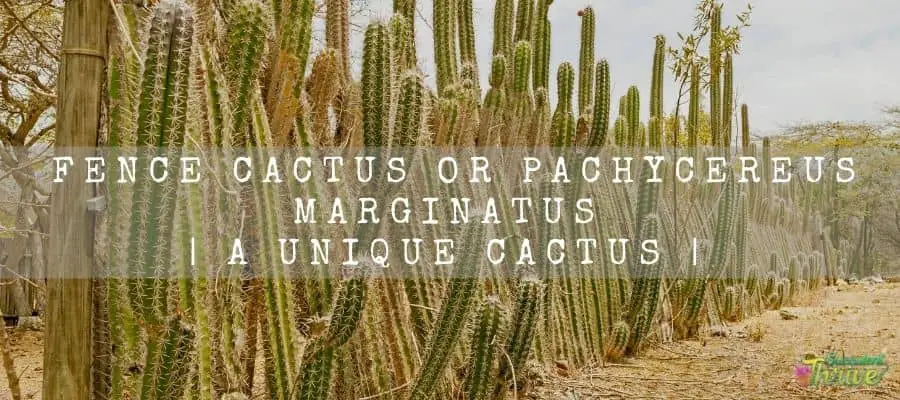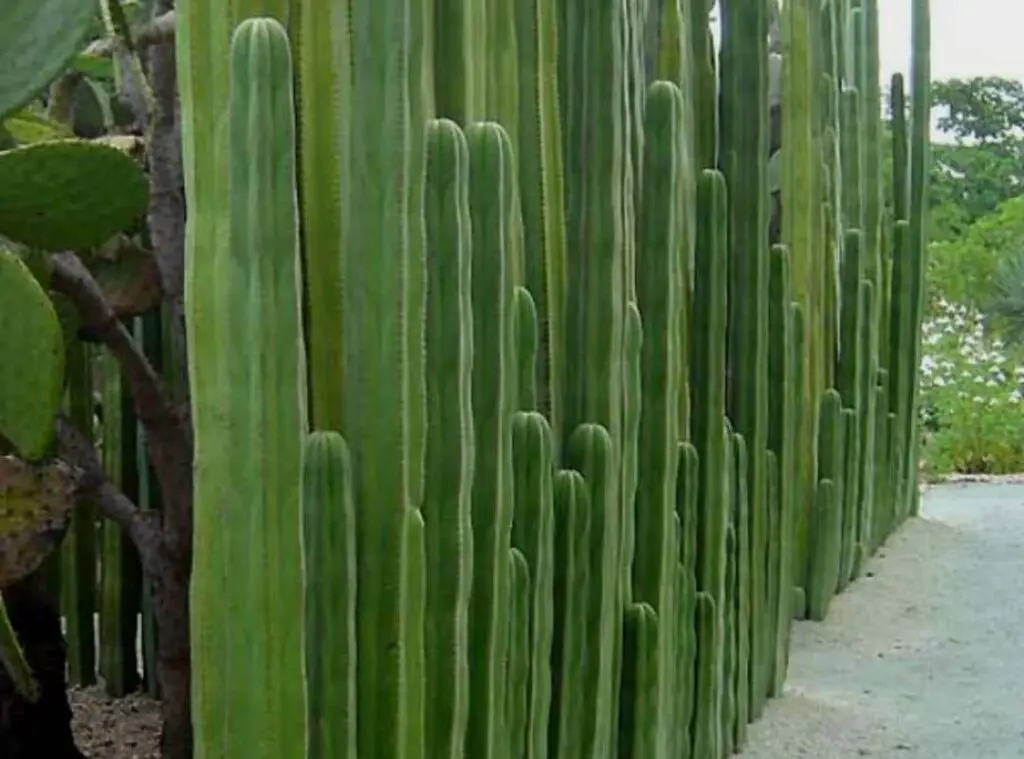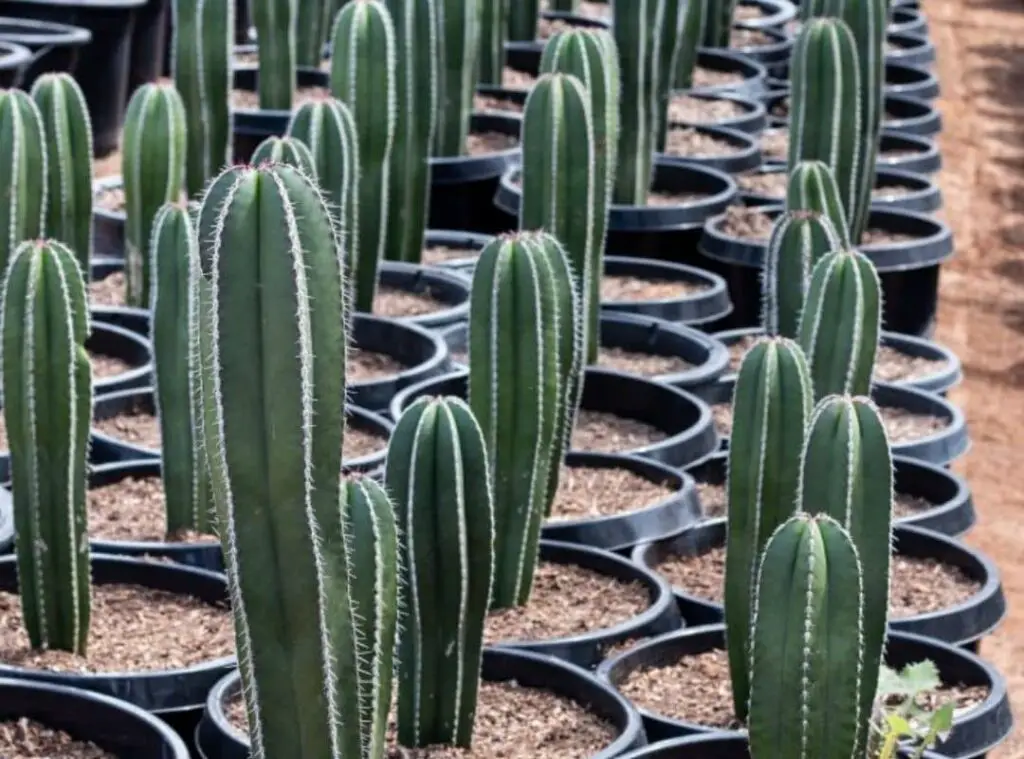Fence cactus or Pachycereus marginatus cactus are native plants to Central Mexico. They are commonly known as Mexican Fence post cactus.
In fact, they tend to grow as barriers. Besides, they use them for living fences as well. Further chances are that they end up growing them without even knowing the proper names of the plants.
fence cactus usually grows as columnar cactus. They would be about 15 feet when they grow to their best potential.

However, when you grow them as indoor plants, they would only grow up to meters maximum. These are the types of plants which can self-sustain.
They can thrive well in harsh environments. If you were looking to grow a plant which requires a minimum care treatment, fence cactus would be the one for you.
So, if these facts have already made you excited to have them, go through this article as you can learn on how you should look after these plants well.
How do I identify Fence cactus?
Fence cactus grows as upright plants. Further they would grow in clumps as well. Their stems would be unbranched.
Moreover, they would grow up to a maximum height of 15 m when they grow in the wild. However when you grow them as houseplants, they would only get as tall as 4 m only.
Fence cactus stems would form in an erecting manner. The stem color would be dark green, and you will feel their epidermis surface is slightly rough when you try to touch it. They may carry 5-7 ribs as well.
Fence cactus areolas would be white in color and glandular. They would form in a longitudinal line. Besides, they would form one yellowish central spine and it would be 1cm in length.
Fence cactus produce flowers which you could spot in pink to greenish. They would flower during spring. Moreover, they produce a fruit item which is yellowish to reddish in color.
They would be spiny as well. Fence cactus fruit would be 4 cm in diameter when they grow to their fullest. Further those fruits contain seeds which you could spot in black.
Size of the plant
Fence cactus would grow up to a maximum height of 15 m when they grow in their natural habitat. On the other hand, when you grow them, they would reach a maximum height of 4m only.
Growth rate
Fence cactus are slow growing plants just like some of their cacti counterparts. You can grow them as houseplants as they do not require any specific requirement from you.
As such you can categorize them as low maintained plants. If you grow them outdoors, they will grow somewhat faster than indoor grown plants. If you provide the right care tips, they will grow from one meter in height annually.
One look care guide
| Botanical Name | Pachycereus marginatus |
| Common Name | Mexican Fence post cactus |
| Plant Type | Cactus |
| Mature Size | 4 m in height when grown indoors 15 m in height when grown in the wild |
| Sun Exposure | Full sunlight |
| Soil Type | Well-draining |
| Soil pH | Slightly acid (6.1 – 6.5) Neutral (6.6 – 7.3) Slightly alkaline (7.4 – 7.8) |
| Bloom Time | spring |
| Flower Color | pink to greenish |
| Hardiness Zones | USDA hardiness zone 10 |
| Native Area | Central Mexico |
| Toxicity | Non toxic |
| Average price | 4 $ |

How do you take care of fence cactus?
Light Requirement
It is important that they get full and direct sunlight during spring and summer. That will help them to grow vigorously and firmly.
Fence cactus are vitamin D lovers. Since they grow in the deserts, they are tolerant of heat and in parched conditions.
As such you should not never worry about placing them outdoors during intense afternoon hours. If you wish to have them in your indoor gardening collection, you can choose a brightly lit place for that.
That will allow the plants to absorb as much as light they can. During winter you can just let them be as they do not have any specific requirement in terms of sunlight. They would go dormant during winter.
Temperature and humidity
What I would always recommend to you is to provide the same temperature they get when they grow in the wild.
Those conditions would suit them the best. When you grow them as indoor plants best would be to grow them at room temperature.
fence cactus are tolerant of a temperature range between 25 degrees Fahrenheit (-3.9 degrees Celsius) to 50 degrees Fahrenheit ( 10 degrees Celsius).
Ideally a temperature between this range would be the best for them. fence cactus are tolerant of extreme heat but not humidity.
Excessive humidity levels could be harmful for the healthy growth of the plants. Literally, it would cause root rot and stem rot.
Ultimately, they would end up having fungal diseases as well. Ensure that you water them depending on the humidity level of the area you live in.
Keep in mind that they can store water in their body and that is what helps them to sustain the drought conditions. A humidity level of 30 % would be optimal for the vigorous growth of these plants.
Is it cold hardy?
USDA Hardiness Zone
fence cactus prefer to grow in USDA hardiness zones 10.
Watering Requirement
Fence cactus can self-sustain as they are hardy plants. Since they are adapted to grow in drought conditions, you need to always mimic the same conditions they get in their natural habitat when you grow them as well.
Do not over water the plants at any given time.You only need to keep in mind taht you need to water them only if their soil is dry only.
Frequency wise, you can water them once every week or once every two weeks during summer. Suspend watering them during winter at all.
The fence cactus wants to go through hibernation during winter. During the rest of the seasons, you need to always keep them dry.
Soil Requirement Type / pH
Fence cactus can thrive well in nature even if there are rocks around the plants. Literally the fence cactus roots can absorb nutrients from the rocks. However, when you grow them as houseplants, you need to always choose a well-draining soil mix
This literally means, when you water them, excess water should always drain away from the soil without retaining in the pot.
I recommend using a cactus or succulent soil mix for this as they have excellent drainage. Refrain from keeping the soil moist as it would be unhealthy for the plants.
Pot size Potting and Repotting
I recommend using a sturdy pot to grow the fence cactus plants. They can host the tall growing of the fence cactus cactus.
Besides, the pot needs to have sufficient draining holes as well. That will aid the draining of the pots. Additionally, it will provide a good aeration too.
The right material should be a clay pot as they are high in porosity. Consequently, it would release the moisture.
fence cactus plants are low maintenance plants.As such, you can repot them less often. To be precise, you may repot them once every two years.
Having said that if you spot the plants have outgrown from the pots, you need to consider repotting them. Besides, if the soil is not well draining, best would be to repot them in a fresh pot which has excellent drainage.
You can follow the same steps which you do to pot a cactus when repotting the fence cactus plants. Further you need to always select a fresh pot to transplant them.
Next you can add some fresh soil mix and add a little bit of fertilizer as well. Best recommended season to conduct repotting would be spring.
Where to Plant
Since these plants are used to grow in drought areas, you need to ensure that they get the bright sunlight most of the time.
Bear that in mind when selecting a place to plant these precious plants, Additionally, when you grow them indoors ensure that you choose a soil medium which has an excellent drainage.
Fertilizer and time of year
Fence cactus do not require regular fertilizing. Having said that, a light feeding them during their active growing period would be beneficial to boost the growth of the plants.
You may go ahead with a store-bought fertilizer for these plants. Further,best is to feed them with fertilizers during their active growing season.
Ensure that the fertilizer which you use is one which has balanced amounts of Nitrogen, Phosphorus and potassium.
You need to refrain from feeding the fence cactus during their dormancy as they will be literally in the relaxing mode during dormancy. Ideally you need to stimulate the hibernation of the plants.

Flower
Fence cactus produce flowers in pink to greenish colors.
You could spot them blooming during spring. Those flowers will arise from the areoles of the plants. There will usually be two flowers per areole in the plants. They would be about three to four cm in length.
Dormancy
Fence cactus are winter dormant plants.
Toxicity
Fence cactus are nontoxic plants for both animals and for pets.
Common bugs and illnesses
Fence cactus are usually strong contenders when it comes to resisting the illnesses. However, they could be victims of fungal attacks on and off.
You could commonly spot this when they are exposed to moisture in the soil. The prolonged exposure for moisture would result in so many unnecessary problems.
Additionally ensure that you expose them to sufficient sunlight levels as well. Fence cactus are self-sustaining plants generally.
However, it is important that you fulfill their growing necessities as it will help them to stay problem free.
All you have to do is to expose them to proper sunlight and keep a track on the soil’s moist conditions and grow them in a well-draining soil mix.
Besides, do not ever leave them exposed to freezing temperatures for too long. Moreover, refrain from exposing them for high humidity levels as well.
Special Care tips
Fence cactus require a minimum care treatment as aforesaid. However, the most important thing you need to keep in mind is that you should never over water them.
Further ensure that the excess water is always draining from the pots. Consider repotting the plants periodically.
fence cactus are a flowering set of plants as aforesaid. However, those flowers would not stay alive for a long time.
Instead, they would stay alive for a shorter period and would end up wilting. In that circumstance, you may consider pruning them from the plants.
fence cactus benefits
Fence cactus are used for live fences as they grow high naturally. . Further fence cactus are bulky plants which carry spines as well.
These characteristics also make them perfect additions for live fences as they would provide an extra protection. Moreover, they use landscaping as well.
How to propagate fence cactus
First and foremost, the best season to conduct propagation would be the warmer season. You may conduct their propagation through seeds or through the stem cuttings.
If you wish to propagate them by seeds, you need to first arrange a germination tray or a pot where you have added a well-draining soil mix.
Next you may spread the seeds in the mix and then water them lightly. Do not over water or expose them to intense sunlight. Once you spot them producing new growths you can treat them as explained in the above.
In addition to that if you wish to propagate them by cuttings, you need to first make a cutting at the joint of the segment to the main parent plant.
Next place the cuttings in a warmer fry place and allow them to develop callous. Next you may plant them in the new pot and leave them exposed in the full sunlight.
However, do not expose them for full sunlight during an intense summer as it would be unhealthy.
Conclusion
Before concluding, trust this article was helpful for you and that you were able to learn on how to look after them well. So, start growing these beauties and enjoy watching them flourish !
Read Next : 19 Caudiciform Succulents | Different Kind Of Succulents |
